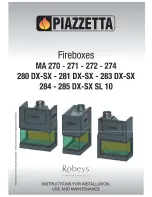
REMINGTON QFP40 Direct Vent FIREPLACE
Page 28
250-4721 JUNE 2001
VENTING
VENTING INSTALLATION OPTIONS & GUIDELINES
There are four types of direct vent system installations approved for use with the REMINGTON
QFP40. It is very important to maintain a balance between the combustion air intake and the flue
gas exhaust venting system. The types of installation are:
Horizontal Termination (Figure 1)
Vertical Termination (Figure 2)
Into a Class A Metal Chimney (Figure 3)*
Into a Masonry Chimney (Figure 4)*
*USA installations only
Note: Certain limitations as to vent and vertical termination configuration apply, and
must be strictly adhered to. Read this manual carefully.
When planning your installation, it will be necessary to select the proper length of vent pipe for
your particular requirements. The vent graph on page 32 will show the relationship between vertical
and horizontal side wall venting, and will help you to determine the various vent lengths permitted.
It is also important to note the wall thickness. Select the amount of vertical rise desired for “vertical-
to-horizontal” type installations. To determine the length of your pipe required for vertical
installations, measure the distance from the application flue outlet to the ceiling, the ceiling
thickness, the vertical rise in an attic or second story, and allow for sufficient vent height above the
roofline. For two-story applications, fire stops are required at each floor level. If an offset is
needed in the attic, additional pipe and elbows will be required.
When installing this appliance into an existing masonry chimney, it is important to carefully measure
the length of flex needed to reach from the appliance outlet to the termination cap. If the flex
length is too short, a flex coupler will be needed to attach an additional length of flex liner to make
up the difference. If the flex length is too long, the liner could sag below the appliance outlet,
which could result in a potential fire hazard.
10'
2'
Minimum
3'
Minimum
A masonry chimney or a factory-built chimney must be the required height above the roof
and any other nearby obstructions. The chimney must be at least three feet higher than
the highest point where it passes through the roof and at least two feet higher than the
highest part of the roof or structure that is within ten feet of the chimney, measured
horizontally. See 2-10-3 diagram below. These are safety requirements and are not
meant to assure proper flue draft.
2-10-3 VERTICAL TERMINATION RULE
















































